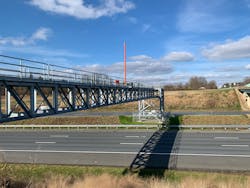Davidson County Airport Completes 10-Year MALSR Installation Project
In July 2021, The Davidson County Airport (EXX) completed the installation of a Runway 6 Medium Intensity Approach Lighting System (MALSR). The system took 10 years to complete and was the first of its kind in North Carolina, crossing a major interstate.
The purpose of the new lighting system was to enhance the safety at the airport, providing pilots with enhanced visual guidance for landing aircraft in poor visibility. Prior to the installation, oftentimes corporate aircraft could not land at EXX in inclement weather conditions because they didn’t have a system in place that could accommodate them.
“It greatly enhances the safety at our airport. It makes it more accessible in low visibility, especially for corporate aircraft coming in, oftentimes which at minimums, if you don't have a landing light system like this, their insurance requirements will not let them land at an airport without guidance like we have out there now,” said Rick Phillips, chairman of the board, Davidson County Airport Authority. “As a pilot I can tell you that coming in on a foggy night or a night when visibility is low, having a MALSR system like [the one] that’s out there, which gives you strobe lights pointing toward the runway, I mean, it's like a miracle versus coming in without it. It is such a game-changer for safety.”
Fly High Lexington FBO Owner and Airport Manager, Karel Van Der Linden said without an upgraded lighting system, the airport was losing business to surrounding airports.
“Because the airport is situated in a high-traffic area between Concord and Charlotte, it was more than necessary to install MALSR,” he said.
Ten Years in the Making
Before the airport could get started, they had quite a few things to consider such as the best runway to put it on, what land is available, obstructions and more.
“Above anything else, to me, the first thing would be to have a really good consulting firm, an airport consulting firm, that knows this stuff like the back of their hand and have them walk with you through it,” Phillips said. “In my opinion, we could never have pulled this off without having a great consulting firm to work with.”
The consulting firm EXX decided to work with was Talbert, Bright & Ellington out of Charlotte. The first step in getting the MALSR project off the ground was for the airport to acquire the necessary land and determine where the best place would be to install the system.
“Then it took several years of negotiating back and forth to finally end up owning the property. From then, I mean, it was just a matter of ordering the materials and having the construction company come in and build it,” Phillips said. “The actual construction of the project, I think, probably was about one year. All the rest of the time was prep of one nature or another.”
The largest time factor in completing the project was working with all the proper entities to ensure that any and all work that was done met the proper rules and regulations.
Because the project involved installing light towers above the interstate, EXX and Talbert, Bright & Ellington needed to work very closely with the North Carolina Department of Transportation (NCDOT).
“During the construction process, there were nights we had to shut the interstate down and divert traffic because our towers come right across the interstate,” Phillips said. “One is on a platform that comes right across the northbound lanes of Interstate 85.”
NCDOT’s largest concern was the location of the vertical components for the cantilever in the overhead structures, making sure that those were far enough away or protected by a guardrail or some kind of barrier if it was needed.
In addition, the design for the structures needed to be reviewed internally by their structural division within Highways to make sure that it met their requirements and that they didn't have any issues.
The project also needed to pass FAA requirements, specifically those outlined in order JO 6850.2B
The largest component on the FAA’s side, was to make sure there was some kind of visual barrier between the lights that flash on the system and traffic that's passing below. Their concern was that any flashing lights would cause some visual distraction to drivers at nighttime. So EXX and Talbert, Bright & Ellington worked with the FAA to install large shields under the light that would allow pilots to still see the lights from above, but block any of those flashing lights from the traffic below.
Once that component was figured out, careful attention was paid to order JO 6850.2B to determine where structures were needed, – whether it be an overhead or cantilever structure – installation of any retaining walls, cabling systems and conduits that had to be installed under the pavement.
Final Steps
Before the MALSR could be operational, it needed a few final stamps of approval.
Representatives from the NCDOT and the FAA first needed to come out to inspect the system, then a test flight from the FAA could be scheduled at which point three flights would be conducted; one during daytime, one during dusk, and one at night checking that all the lights are operating, that the sequencing of the flashing lights is correct, and that visually everything meets their criteria. And at that point, they've already done the ground inspection to check the angle of the lights.
Once everything had been approved during the test flight phase, the system was commissioned.
“It was 10 years' worth of moving one inch at the time it felt like, but I've had zero negative comments about this,” said Phillips. “We've had nothing but positive comments, especially from the corporate pilots that fly in or even sometimes transient pilots. We are a good midway, a good fuel stop between the Northeast and Florida or Gulf Coast. When the weather is low, this is such a game-changer. For me personally, if I were in a situation where I had a choice of two airports and the weather was low, I mean, by all means I would go into one that had a MALSR system as opposed to one that didn't.”
Best in Class
Phillips said the addition of the MALSR system at EXX has been a huge economic driver for the airport.
“When new businesses or prospective businesses in our area are maybe interested in looking at our area, well, one thing that might play into it is if they're not able to bring their airplanes in when the weather is at minimums, and they have to divert to Greensboro or Winston-Salem or back to Concord maybe. Where they can't get in, that could easily play a part in their decision as to whether or not they want to locate with us,” he explained. “With this system they can get in in low weather and low visibility now. We think that's a shot in the arm for them to be more interested in locating in our area.”
Van Der Linden said since installing the MALSR system, the airport has seen an increase in traffic so large that they are planning to expand available hangar space.
“Our hangars are completely full now. We have 60 hangars on the airport, 50 T-hangers, and the rest are corporate hangers and maintenance hangers. Because of the demand for this airport, we are in the process of building eight hangers of 10,000 square feet each,” he said. “We are going to break ground in mid-July and our plan is to start to build at least four 10,000 square feet hangers. We are also in the process to break ground to build a new maintenance facility of 60,000 square feet.”
The Davidson County Airport was awarded the 2022 Mobi Award for Most Voted project and received Honorable Mention in the Small Urban category at the Mobi Awards ceremony, presented by NCDOT for the state’s best multimodal projects. This represents the first time that a general aviation airport in North Carolina has won this prestigious award.
“This this is just a huge, huge safety tool or safety enhancement to any airport,” Phillips said. “Whether you're looking for it to help your airport grow, for your airport to help promote commerce and growth in the area, or whether it's just transient pilots flying in or whatever, it's just a great safety tool. You're much less likely to have somebody maybe to experience an accident trying to get in in low weather and not having a system like this.”



